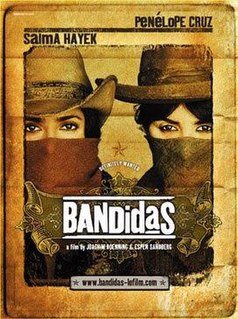
Bandidas is a 2006 French-Mexican-American Western action comedy film starring Salma Hayek and Penélope Cruz directed by Norwegian directors Joachim Rønning and Espen Sandberg and produced and written by Luc Besson. It tells the tale of two very different women in late 19th century Mexico who become a bank robbing duo in an effort to combat a ruthless enforcer terrorizing their town.
The real was a currency of Mexico, issued until 1897. There were 16 silver reales to 1 gold escudo, with 8 tlacos to the real. The peso, which circulated alongside the real and eventually replaced it, was equal to 8 reales.

Guns for San Sebastian is a 1968 French action-adventure film based on the 1962 novel A Wall for San Sebastian, written by Rev. Fr. William Barnaby "Barby" Faherty, S.J. The film is directed by Frenchman Henri Verneuil, it stars Anthony Quinn and Charles Bronson. The score is by Ennio Morricone. Filming took place in Sierra de Órganos National Park in the town of Sombrerete, Mexico

Wagons East is a 1994 American Western adventure comedy film directed by Peter Markle and starring John Candy and Richard Lewis. The film was released in the United States on August 26, 1994. Filming took place in Sierra de Órganos National Park in the town of Sombrerete, Mexico and in Durango, Mexico.

The Camino Real de Tierra Adentro was a 2560 kilometer long trade route between Mexico City and San Juan Pueblo, New Mexico, from 1598 to 1882.
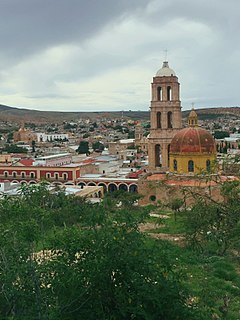
Sombrerete is a town and municipality located in the northwest of the Mexican state of Zacatecas, bordering the state of Durango.
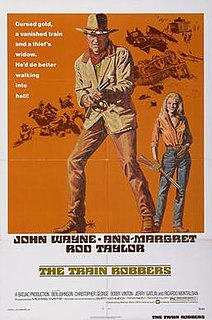
The Train Robbers is a 1973 Western Technicolor film written and directed by Burt Kennedy and starring John Wayne, Ann-Margret, Rod Taylor and Ben Johnson. Filming took place in Sierra de Órganos National Park in the town of Sombrerete, Mexico.

The Soldiers of Pancho Villa is a 1959 Mexican epic historical drama film co-written, produced, and directed by Ismael Rodríguez, inspired by the popular Mexican Revolution corrido "La Cucaracha". It stars María Félix and Dolores del Río in the lead roles, and features Emilio Fernández, Antonio Aguilar, Flor Silvestre, and Pedro Armendáriz in supporting roles.

The Scalphunters is a 1968 American western film starring Burt Lancaster, Ossie Davis and Telly Savalas. The film was directed by Sydney Pollack, with the score written by Elmer Bernstein. Davis was nominated for a Golden Globe for Best Supporting Actor for his performance in the film. Filming took place in Sierra de Órganos National Park in the town of Sombrerete, Mexico

Chalchihuites is a municipality in the Mexican state of Zacatecas in northwest Mexico. The archaeological site of Altavista, at Chalchihuites, is located 137 miles to the northwest of the city of Zacatecas and 102 miles southeast of the city of Durango. Located to the west of Sombrerete in the northwestern corner of the Zacatecas state, it is believed that the site was a cultural oasis that was occupied more or less continuously from AD 100 to AD 1400.

Zacatecas, officially the Free and Sovereign State of Zacatecas, is one of the 31 states which, with the Federal District, comprise the 32 Federal Entities of Mexico. It is divided into 58 municipalities and its capital city is Zacatecas City.

Geronimo is a 1962 Technicolor Western film made by Levy-Gardner-Laven and released by United Artists, starring Chuck Connors in the title role. The film was directed by Arnold Laven from a screenplay by Pat Fielder, filming took place in Sierra de Órganos National Park in the town of Sombrerete, Mexico.
Juan de Tolosa was a Spanish Basque conquistador. He discovered rich silver deposits near the present day city of Zacatecas, Mexico, in 1546.
Antonio Valverde y Cosío (1670–1728) was a prominent entrepreneur and Spanish soldier who served as acting governor of Santa Fe de Nuevo México in 1716 and as interim governor of this territory from 1718 to 1721. His politics were based, in large part, on stopping the French invasion of New Mexico.
The following television stations broadcast on digital channel 23 in Mexico:
The following television stations broadcast on digital channel 18 in Mexico:
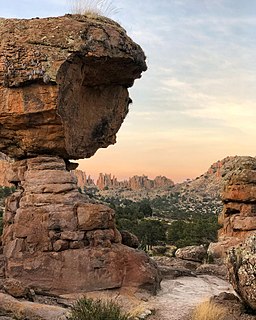
Sierra de Órganos National Park is a national park in Mexico, located in the northwest corner of the municipality of Sombrerete in the state of Zacatecas, near the border with Durango. The park is known for its diverse aridland ecosystem and towering rock formations of the Sierra Madre Occidental, which are reminiscent of organ pipe cactuses or the pipes of the musical instrument, from which the park takes its name.
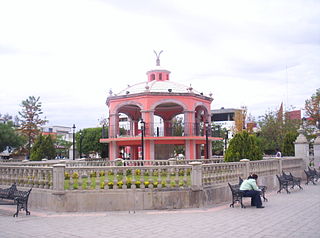
Río Grande is a municipality in the Mexican state of Zacatecas.
XHPSTZ-FM is a radio station on 90.7 FM in Sombrerete, Zacatecas. It is known as La Bonita del Norte.

















